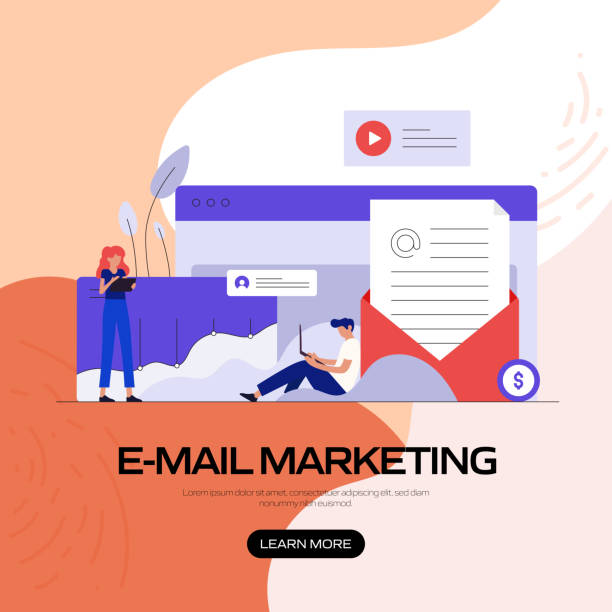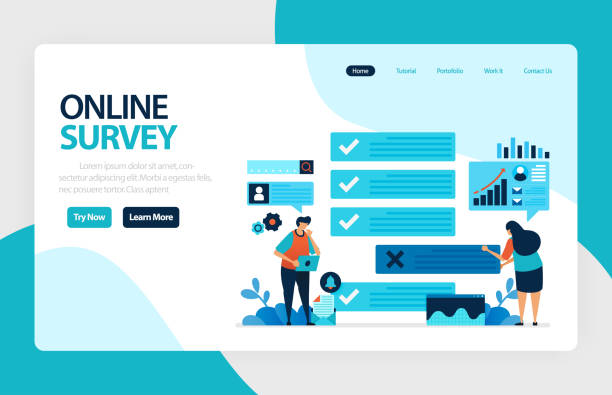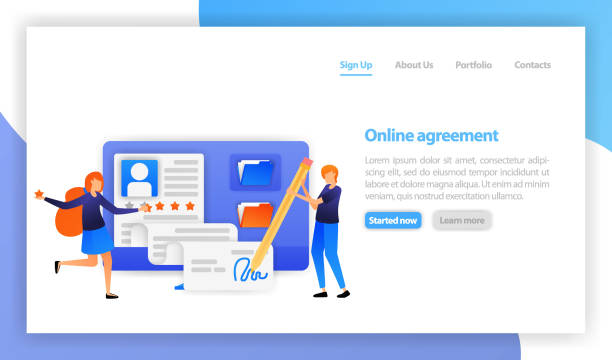An Introduction to the Importance of Responsive Website Design

In today’s world, where users access the internet from various devices, #Responsive_Website_Design is no longer a luxury option, but a vital necessity.
Imagine having a website that looks great on desktop computers, but is unreadable, cluttered, and unusable on smartphones or tablets.
This is where the importance of responsive website design reveals itself.
This approach ensures that your website is displayed correctly and provides a flawless experience, regardless of the user’s device screen size.
Responsive Web Design means building websites whose content and layout automatically adjust to the user’s device screen size.
This adjustment includes changing the size of images, fonts, the order of columns, and even site navigation so that users can enjoy an optimal User Experience (UX) on any device.
This approach is highly significant from an educational perspective because it teaches web designers how to build flexible and versatile sites that can respond to changing market needs.
It also explains to users why some sites work better on mobile.
Without responsive design, businesses will lose a large portion of their audience who connect to the internet via mobile or tablet.
This is a paradigm shift in web design that has transformed websites from static entities into fluid and dynamic ones.
Worried about losing customers because you don’t have a professional e-commerce site?
With e-commerce site design by Rasavveb, forget these worries!
✅ Significant increase in sales and conversion rate from visitor to customer
✅ Professional and user-friendly design that builds customer trust
⚡ Get free consultation from Rasavveb
Key Principles of Responsive Design

To successfully implement #Responsive_Website_Design, three key principles must be considered: media queries, fluid grids, and flexible images.
Together, these principles provide the necessary structure and dynamism for a responsive website.
Media Queries are perhaps the most crucial component in this process.
This CSS3 capability allows designers to apply different styles based on device characteristics such as screen width, height, orientation (portrait or landscape), and even resolution.
For example, you can define rules that when the screen width is less than 768 pixels (typically for tablets and mobiles), the site’s navigation menu transforms into a hamburger icon, or content columns stack vertically instead of side-by-side.
Media queries are specialized and powerful tools that form the core of adaptive design.
The second principle is Fluid Grids.
Instead of using fixed widths (pixels) for element layout, this approach uses relative units like percentages.
This means that the width of columns and different sections of the site changes proportionally to the total page width.
In this way, content always fills the available space optimally, preventing overflow or excessive empty space.
This is an important educational approach that helps designers shift from pixel-based thinking to ratio-based thinking.
Finally, Flexible Images ensure that images are also scalable with the screen size.
By setting the max-width: 100% property for images, images are prevented from becoming larger than their container, and they are always displayed at the appropriate size.
These principles, collectively, provide a strong framework for responsive website design and form the foundation of any modern and user-friendly website.
Tools and Frameworks for Responsive Design

For effective implementation of #Responsive_Website_Design, numerous tools and frameworks exist that significantly simplify the developer’s work.
These tools, especially for those new to web design, serve as guiding aids and streamline the process.
One of the most popular and well-known frameworks is Bootstrap.
Bootstrap is a CSS, HTML, and JavaScript framework that provides a complete set of ready-to-use components (such as forms, buttons, navigations) and a strong grid system for responsive design.
Due to its ease of use and comprehensive documentation, this framework is an excellent option for getting started.
Using Bootstrap, developers can quickly build responsive websites without needing to write a large amount of CSS code from scratch.
In addition to comprehensive frameworks, newer CSS techniques like Flexbox and CSS Grid offer a specialized and powerful approach to responsive layout.
Flexbox is ideal for one-dimensional layouts (rows or columns), while CSS Grid is designed for complex two-dimensional layouts (rows and columns simultaneously).
These tools give designers unparalleled control over how elements are placed on different pages.
Choosing the right tool depends on the project’s complexity, personal preferences, and the team’s skill level.
However, without a doubt, using these frameworks and techniques can significantly reduce development time and improve the quality of responsive website design.
| Tool/Framework | Type | Main Use | Advantages | Potential Disadvantages |
|---|---|---|---|---|
| Bootstrap | CSS/JS Framework | Rapid development of responsive websites with ready-made components | Comprehensive, strong documentation, large user community, high development speed | Relatively large file size, similar designs |
| Flexbox | CSS Module | Layout of elements in one dimension (horizontal or vertical) | Precise control over alignment and space distribution, high efficiency | Only for one dimension, requires learning new concepts |
| CSS Grid | CSS Module | Complex and two-dimensional (grid) layout | Most powerful tool for overall page layout, high flexibility | Slightly higher learning curve, older browser support |
The Impact of Responsive Design on User Experience UX

The most important reason for adopting #Responsive_Website_Design is its direct and positive impact on #User_Experience (UX).
A website that functions and looks good on any device not only satisfies the user but also encourages them to stay and explore more of the site.
When a user doesn’t have to constantly zoom and scroll the page to view content, they will feel more comfortable and efficient.
This is particularly vital for website accessibility.
Responsive websites ensure that users with special needs, such as visually impaired individuals who use screen readers or high zoom, can also have full access to content.
Ease of use (Usability) across different devices is the core of an excellent UX.
Although this is an analytical content, it can also be examined from an explanatory angle as to why this approach is beneficial for end-users.
A website that loads quickly and is optimized on mobile allows users to access information anytime, anywhere, which is a great competitive advantage.
This becomes even more important in today’s world where mobile takes precedence.
A responsive website design not only improves the site’s appearance on various devices but also streamlines the flow of information and user interaction with the site.
Since users expect a consistent user experience on every platform, failure to comply with this standard can lead to audience churn and reduced engagement.
This demonstrates how adaptive design has become an inseparable part of digital marketing strategies.
Are you bothered by losing customers due to your e-commerce site’s outdated appearance or slow speed? Rasavveb’s expert team solves these problems with professional e-commerce site design!
✅ Increase customer trust and your brand’s credibility
✅ Stunning speed and excellent user experience
Get a free consultation with Rasavveb now ⚡
Responsive Design and SEO

The relationship between #Responsive_Website_Design and #SEO is very close and vital.
Google and other search engines prefer websites that offer a better user experience across different devices, and this is one of the most important reasons to adopt the responsive website design approach.
Since 2015, Google officially announced that responsiveness is a ranking factor in mobile search results, and with the introduction of Mobile-First Indexing, it shifted its priority to mobile versions of websites.
This means that Google first crawls and indexes the mobile version of your site, and if this version is not optimized, your ranking in search results will suffer.
This is specialized and analytical content that shows how design decisions impact digital marketing.
Additionally, responsive websites have only one URL, which makes them easier for search engines to manage.
In contrast, separate mobile websites (like m.example.com) require additional configurations such as canonicalization to prevent duplicate content issues, which can increase SEO complexities.
Improved Bounce Rate and increased Dwell Time are also SEO benefits for responsive websites.
When users have a good experience on your site, they are more likely to stay longer and view more pages, which sends positive signals to search engines.
Finally, loading speed is also an important ranking factor.
An optimized adaptive design can help reduce loading time, especially on mobile devices where internet connection might be slower.
This synergy between design and SEO has made responsive design an essential investment for any online business.
Challenges and Solutions for Implementing Responsive Design

Despite numerous benefits, implementing #Responsive_Website_Design can also come with challenges, and being aware of them and finding suitable solutions is crucial for developers and businesses.
This section provides analytical and guiding content.
One of the biggest challenges is managing #site_performance on different devices.
Responsive websites might have high-quality images or many CSS and JavaScript files, which can take a long time to load on mobile devices with slow internet.
The solution to this challenge is Image Optimization; using appropriate image formats (such as WebP), compressing images, and employing lazy loading techniques can significantly improve speed.
Also, minification of CSS and JS files and leveraging CDN (Content Delivery Network) are very effective.
Another challenge is #design_and_development_complexity.
Designing for various screen sizes requires different thinking and more precise planning compared to designing for a fixed size.
This can increase development time and demands more skills from the design and development team.
Using frameworks like Bootstrap and CSS Grid can reduce this complexity, but teams must be well-familiar with these tools.
#Testing_and_debugging on different devices is also an important challenge.
Despite simulators in browsers, actual testing on physical devices is essential.
Using tools like Google Chrome DevTools to simulate different devices and perform usability tests can be helpful.
Finally, the thought-provoking content is whether responsive design is always ideal for all projects.
Sometimes, for very complex projects or web applications with a completely different mobile user experience, a Mobile-first approach or even Native Apps might be more suitable.
But in most cases, responsive website design offers the best balance between efficiency, cost, and user experience.
Case Study of Responsive Website Design in Different Industries

#Responsive_Website_Design is not just a technical approach but a business strategy that has yielded tangible results across various industries.
A case study on this topic provides a factual and analytical overview of its applications and benefits in the real world.
In the #E-commerce industry, responsive design plays a crucial role.
Most online purchases, especially among younger age groups, are made via mobile devices.
A website that is easy to navigate and shop on mobile can lead to increased conversion rates and sales.
For instance, major retailers like Digikala or Amazon have heavily invested in responsive design and mobile experience to allow customers to easily view, compare, and purchase products.
In the media and #news_blog industry, the speed and accessibility of content on any device are of paramount importance.
Readers expect to easily read breaking news anywhere, even on the go.
News websites like BBC Persian or The Guardian use responsive website design to ensure their articles and videos are optimally displayed on phones, tablets, or desktops, providing an enjoyable reading experience.
This helps increase page views and reduce bounce rates.
For freelancers and companies with #online_portfolios or work samples, adaptive design is doubly important.
A graphic designer, photographer, or web developer must be able to showcase their work professionally to potential clients on any device.
A responsive portfolio website demonstrates the individual’s professionalism and up-to-date skills.
These examples show how responsive design is a strategic investment for retaining and attracting audiences in any industry.
| Industry | Example (Internal/External) | Responsive Advantage | Business Impact |
|---|---|---|---|
| E-commerce | Digikala / Amazon | Easy access to products, smooth navigation, optimized mobile shopping process | Increased conversion rate, increased mobile sales, customer satisfaction |
| Media and News | BBC Persian / The Guardian | High readability on any device, fast article loading, integrated user experience | Increased page views, reduced bounce rate, reader loyalty |
| Portfolio and Personal | Designers’/Photographers’ Websites | Professional display of portfolios, easy access for potential employers | Attracting more customers, showcasing technical competencies, increasing credibility |
The Future of Responsive Design

The future of #Responsive_Website_Design, with the rapid pace of technological advancements, is constantly evolving and raising new concepts for discussion and #thought-provoking_content.
What we know today as responsive design is just the foundation of what we will witness in the future.
With the emergence of new technologies and improved browser capabilities, more advanced approaches are appearing that further enhance the user experience.
One of the most important future trends is the focus on Progressive Web Apps (PWAs).
PWAs are websites that can offer a user experience similar to native applications in the browser; capabilities like offline work, sending notifications, and installation as an icon on the device’s home screen, without needing to download from app stores.
This approach elevates adaptive design to a new level and blurs the lines between websites and native applications.
Accelerated Mobile Pages (AMP) will also continue to maintain its importance for some types of content, especially news and articles.
AMP improves the mobile user experience by focusing on extremely fast loading speeds, although it imposes some design and coding limitations.
Furthermore, with continuous advancements in CSS, we will see the emergence of new and more powerful features that make responsive website design easier and more efficient.
Capabilities such as Container Queries (which allow you to apply styles based on the parent element’s size, not the entire viewport size) and Cascade Layers (for better management of style priorities) paint a brighter future for responsive design.
The question is, will websites in the future become so intelligent that they adapt themselves based on user behavior and even the surrounding environment (like ambient light)? This is an exciting field for research and development that could completely revolutionize the web experience.
Did you know that a weak corporate website loses you many opportunities daily? With professional corporate website design by Rasavveb, solve this problem forever!
✅ Create a powerful and reliable image for your brand
✅ Targeted attraction of new customers and increased sales
⚡ [Get Free Website Design Consultation]
Important Tips for Designers and Developers

For designers and developers aiming to succeed in #Responsive_Website_Design, adhering to best practices is essential.
This section serves as an expert guide to help improve the quality and efficiency of responsive websites.
The first and most important tip is “Mobile-First” thinking.
Instead of designing for desktop and then attempting to compress it for mobile, first design the user experience for the smallest screen, and then gradually expand it for larger screens.
This approach ensures that the most important content and functionalities are accessible to mobile users, and that the site is light and fast from the start.
#Clean_and_semantic_coding is also vital.
Using HTML and CSS in an organized and maintainable way makes the development and update process easier.
Avoiding boilerplate code and optimally using CSS features like Flexbox and Grid helps build flexible and high-performing websites.
#Image_optimization is very important from a performance perspective.
As previously mentioned, using appropriate formats, compressing, and lazy-loading images can significantly increase site loading speed, which is crucial for both user experience and SEO.
Continuous and comprehensive #multi-device_testing is the culmination of every responsive website design project.
Never rely solely on simulators.
Test your site on various physical devices (mobile, tablet, laptop) with different sizes and operating systems to ensure its correct functionality.
This includes checking touch interactions, loading speed on different networks (3G, 4G, Wi-Fi), and UI stability.
By following these tips, designers and developers can build powerful and user-friendly responsive websites.
Why Your Business Needs Responsive Website Design

Finally, let’s address the question of why your #business, regardless of its size or industry, has an urgent need for #Responsive_Website_Design.
This is explanatory and engaging content that highlights the business aspects of this approach.
The first reason is #increased_sales and conversion rates.
Global statistics show that a significant portion of web traffic and online purchases occur via mobile devices.
If your website is not optimized for mobile, you will not only lose potential customers but also create an unpleasant experience for them, which rarely leads to conversion.
Responsive website design ensures that every visitor, regardless of the device they use, has the best possible access to your products or services, and that the purchasing or contact process is easy and smooth for them.
The second reason is improved SEO ranking and online visibility.
As previously mentioned, Google gives higher scores to responsive websites.
By having a responsive site, you will not only be more visible in mobile searches but also perform better in overall search results, which means more traffic and ultimately more customers.
Third, increased #customer_loyalty and positive #branding.
A well-designed website that works excellently on every device creates a positive image of your brand in the customer’s mind.
This shows that you care about your customers’ needs and strive to provide the best possible experience.
This credibility and trust lead to customer loyalty and repeat purchases.
Fourth, reduced costs and ease of maintenance.
Instead of developing and maintaining two or more separate versions of a website (one for desktop, one for mobile), with responsive website design, you have only one codebase.
This significantly simplifies management, updates, and debugging, and reduces development and maintenance costs in the long run.
Ultimately, adaptive design is not just a technical choice but a strategic decision to guarantee the future and growth of your business in the digital space.
Frequently Asked Questions
| Question | Answer |
|---|---|
| What is responsive website design? | Responsive Web Design is an approach where the design and layout of a website automatically adjust to the screen size and device of the user (such as desktop, tablet, mobile) to provide the best user experience. |
| Why is responsive website design important? | With the increasing use of mobile devices and tablets for browsing the internet, responsive design ensures that your website is displayed well on any size and that users do not need to zoom or scroll horizontally, which leads to an improved user experience and reduced bounce rate. |
| What are the main techniques used in responsive design? | The three main techniques include Flexible Grids, Flexible Images, and Media Queries in CSS. |
| What is a Media Query? | A Media Query is a CSS feature that allows you to apply different styles based on the user’s device characteristics such as screen width, height, orientation (vertical or horizontal), and resolution. |
| What impact does responsive design have on SEO? | Google prefers responsive websites and ranks them higher in mobile search results. Also, an improved user experience leads to a reduced bounce rate and increased user time on site, which are positive signals for search engines. |
And other advertising services from Rasavveb Advertising Agency:
Smart Content Strategy: A combination of creativity and technology to attract customers by using real data.
Smart UI/UX: A creative platform to improve campaign management with precise audience targeting.
Smart Content Strategy: Designed for businesses seeking user engagement through attractive UI design.
Smart Brand Identity: A combination of creativity and technology to increase click-through rates by using real data.
Smart SEO: A combination of creativity and technology for online growth through Google Ads management.
And over a hundred other services in the field of internet advertising, advertising consultation, and organizational solutions.
Internet Advertising | Advertising Strategy | Advertorial
Resources
Future of Responsive Design
Global Responsive Website
Bright Future of Website Design
Responsive Website for International Users
? To boost your business in the digital world, Rasavveb Afarin Digital Marketing Agency, specializing in responsive website design and providing comprehensive digital marketing solutions, is always by your side to help you reach the peak of success.
📍 Tehran, Mirdamad Street, next to Bank Markazi, Kazerun Jonubi Alley, Ramin Alley, No. 6




